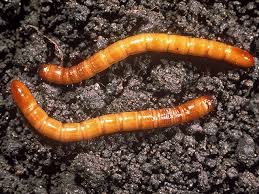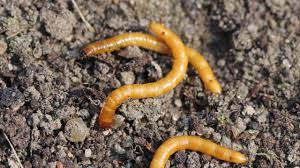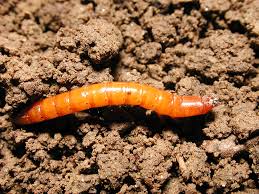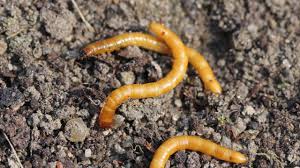Wireworms, scientifically known as Elateridae larvae, are slender, cylindrical insects with a tough exoskeleton. These larvae belong to the click beetle family and are considered agricultural pests. Wireworms are a concern for farmers as they feed on the roots and underground parts of various crops, impacting plant growth.
These tiny creatures undergo a complex life cycle. The adult click beetles lay eggs in the soil, and from these eggs, wireworm larvae emerge. These larvae can live in the soil for several years, depending on environmental conditions. Wireworms are known for their slow movement, resembling a small, wiry wire—hence their name.
One of the primary challenges posed by wireworms is their ability to damage a wide range of crops, including potatoes, carrots, corn, and other root vegetables. Their feeding activity can result in reduced crop yields and economic losses for farmers. Integrated pest management strategies are often employed to control wireworm populations, combining cultural, biological, and chemical methods to mitigate their impact on crops.
Crop rotation is a common cultural practice to help control wireworms. By alternating the types of crops planted in a particular area, farmers can disrupt the life cycle of these pests and reduce their numbers. Additionally, the use of resistant crop varieties and planting times can contribute to effective wireworm management.
Biological control methods involve introducing natural enemies of wireworms into the ecosystem. Predatory beetles and nematodes are among the organisms that can help regulate wireworm populations. These natural enemies can contribute to maintaining a balance in the soil ecosystem, preventing wireworms from reaching damaging levels.
Chemical control, such as the use of insecticides, is another approach to manage wireworms. However, it’s essential to use these chemicals judiciously, considering their potential impact on the environment and non-target organisms. Sustainable and environmentally friendly practices are increasingly emphasized in modern agriculture to minimize the ecological footprint of pest control measures.
Wireworms, or Elateridae larvae, pose a significant challenge in agriculture due to their feeding habits and potential damage to various crops. Effective management strategies involve a combination of cultural, biological, and chemical approaches to mitigate their impact and sustainably protect crop yields. Farmers continue to explore innovative solutions to address the ongoing challenge of wireworm infestations and ensure the health and productivity of their crops.
Read Also: Boysenberries: History, Nutrition, Health Benefits and Growing Guide
Plants Affected by Wireworms (Elateridae larvae)

Wireworms can affect a wide variety of plants, causing damage to their roots and underground structures. Some of the common plants affected by wireworm infestations include potatoes, carrots, corn, and other root vegetables. These pests are particularly problematic for crops that rely on healthy root systems for optimal growth and development.
In addition to root vegetables, wireworms can also impact other crops such as cereals, legumes, and grasses. The feeding activity of wireworm larvae in the soil can lead to stunted growth, reduced crop yields, and overall poor plant health. This makes it essential for farmers to be vigilant and adopt effective pest management strategies to protect a diverse range of crops from wireworm damage.
Crop rotation is a common practice employed by farmers to mitigate the impact of wireworms on specific plants. By alternating the types of crops grown in a particular area, farmers disrupt the life cycle of wireworms and reduce their ability to target a specific crop continuously. This helps maintain the health of the soil ecosystem and minimizes the risk of extensive wireworm damage.
Understanding the plants that are susceptible to wireworm infestations is crucial for implementing targeted and sustainable pest management practices. By adopting integrated approaches that consider the specific needs and vulnerabilities of different crops, farmers can work towards minimizing the economic losses caused by wireworms while promoting the overall resilience of their agricultural systems.
Damages Caused by Wireworms

Wireworms, as agricultural pests, inflict various damages on crops, primarily through their feeding activities targeting plant roots. The consequences of wireworm infestations include:
1. Reduced Crop Yields: Wireworms feed on the roots of plants, hindering the absorption of nutrients and water. This can lead to stunted growth and, ultimately, reduced crop yields. Farmers may experience financial losses due to diminished harvests caused by wireworm damage.
2. Weakened Plant Health: As wireworms consume the roots of plants, the affected crops become more susceptible to other stressors, such as diseases and environmental factors. Weakened plant health can compromise the overall vitality of the crop, making it less resilient to various challenges.
3. Crop Quality Issues: The quality of harvested crops can be negatively impacted by wireworm damage. For example, root vegetables like potatoes and carrots may develop deformities or irregularities, affecting their market value and consumer appeal. Wireworm-induced damage can result in a lower quality of produce.
4. Disrupted Crop Emergence: Wireworms can interfere with the germination and emergence of crops by damaging seeds and seedlings in the soil. This disruption in the early stages of plant development can lead to uneven stands and delayed crop maturity, further contributing to yield reductions.
5. Increased Susceptibility to Diseases: The wounds caused by wireworm feeding create entry points for pathogens, making the affected plants more susceptible to diseases. This secondary impact can exacerbate the overall damage inflicted by wireworms on crops.
6. Economic Losses: Farmers may incur economic losses due to the decreased productivity and quality of wireworm-affected crops. Additionally, the costs associated with implementing pest management strategies, such as the use of insecticides or adopting alternative cultivation practices, contribute to the economic burden of dealing with wireworm infestations.
Addressing the damages caused by wireworms requires a comprehensive approach that includes integrated pest management strategies, crop monitoring, and the implementation of preventive measures. By understanding the specific challenges posed by wireworms, farmers can develop effective strategies to protect their crops and sustain agricultural productivity.
Read Also: Mulberries: History, Nutrition, Health Benefits and Growing Guide
Control and Preventive Measures

Implementing effective control and preventive measures is crucial in managing wireworm infestations and minimizing their impact on crops. Here are various strategies that farmers can employ:
1. Crop Rotation: Alternating the types of crops grown in a particular field disrupts the life cycle of wireworms. Since these pests have specific preferences, changing the crop types can reduce the likelihood of continuous infestations. Crop rotation helps maintain a healthier soil ecosystem and minimizes the risk of wireworm damage.
2. Resistant Crop Varieties: Planting crop varieties that are less attractive or more resistant to wireworms can be an effective preventive measure. Some plant species have natural mechanisms that make them less susceptible to wireworm feeding, providing a level of protection for the crops.
3. Trap Crops: Introducing trap crops that are particularly attractive to wireworms can help divert these pests away from main crops. Once wireworms infest the trap crops, farmers can employ targeted control measures to reduce their populations.
4. Biological Control: Introducing natural predators and parasites of wireworms into the environment can help regulate their populations. Predatory beetles, parasitic nematodes, and certain fungi are examples of biological control agents that can contribute to keeping wireworm numbers in check.
5. Use of Insecticides: In situations where wireworm populations are high and causing significant damage, farmers may resort to chemical control methods. Insecticides specifically designed for wireworm control can be applied to the soil. However, it’s essential to use these chemicals judiciously to minimize environmental impact and consider their potential effects on non-target organisms.
6. Early Planting and Monitoring: Planting crops earlier in the season can help mitigate the impact of wireworms, as younger plants may be more resilient to feeding damage. Regular monitoring of fields for signs of wireworm infestations allows farmers to take timely action and implement control measures before the population becomes too established.
7. Soil Management: Maintaining well-drained soils and avoiding excessive moisture can discourage wireworms, as they prefer moister conditions. Proper soil management practices contribute to creating an environment less favorable for wireworm development.
8. Fall Plowing: Turning over the soil in the fall can expose wireworms to natural predators and environmental factors, reducing their populations. Fall plowing is a cultural practice that disrupts the wireworm life cycle and can be part of an integrated pest management strategy.
By combining these preventive and control measures in an integrated pest management plan, farmers can effectively manage wireworm infestations while promoting sustainable and environmentally friendly practices in agriculture.
Frequently Asked Questions (FAQs) About Wireworms (Elateridae larvae)
1. Q: What are wireworms?
A: Wireworms are the larvae of click beetles, scientifically known as Elateridae. These slender, cylindrical insects are agricultural pests that feed on the roots and underground parts of various crops.
2. Q: What crops are commonly affected by wireworms?
A: Wireworms can affect a wide range of crops, including potatoes, carrots, corn, root vegetables, cereals, legumes, and grasses. They are particularly problematic for crops that rely on healthy root systems for optimal growth.
3. Q: How do wireworms damage crops?
A: Wireworms damage crops by feeding on their roots, hindering nutrient and water absorption. This feeding activity can lead to reduced crop yields, weakened plant health, and issues with crop quality.
4. Q: How long do wireworms stay in the soil?
A: Wireworms can live in the soil for several years, depending on environmental conditions. Their slow development and long lifespan contribute to the challenges of managing their populations.
5. Q: What are some preventive measures for wireworm control?
A: Preventive measures include crop rotation, planting resistant crop varieties, using trap crops, employing biological control with natural predators, and implementing early planting and monitoring practices.
6. Q: Are there chemical control options for wireworms?
A: Yes, in situations with significant wireworm populations, farmers may use insecticides specifically designed for wireworm control. However, it’s important to use these chemicals judiciously to minimize environmental impact.
7. Q: Can wireworms be controlled without using chemicals?
A: Yes, integrated pest management strategies that include cultural practices, biological control, and preventive measures can help manage wireworms without relying solely on chemical interventions.
8. Q: How can farmers monitor for wireworm infestations?
A: Farmers can monitor for wireworm infestations by regularly inspecting fields for signs of damage, using pheromone traps to detect adult click beetles, and employing soil sampling techniques to assess wireworm populations.
9. Q: Do wireworms have natural enemies?
A: Yes, wireworms have natural enemies, including predatory beetles, parasitic nematodes, and certain fungi. Introducing these natural enemies into the environment can contribute to regulating wireworm populations.
10. Q: What is the economic impact of wireworm infestations?
A: Wireworm infestations can result in economic losses due to reduced crop yields, lower crop quality, and the costs associated with implementing pest management strategies. Farmers strive to address these challenges to sustain agricultural productivity.
Read Also: How to Graft an Avocado Tree to Produce Avocado Fruit

